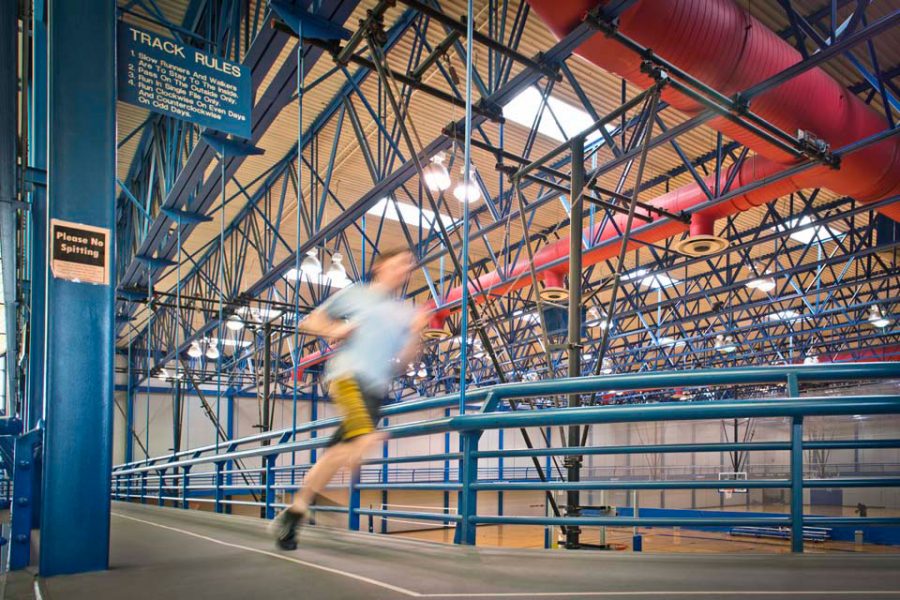SLU is one of top 21 Healthy Campuses
A SLU student runs laps on the indoor track in Simon Recreation Center.
As many high school students go off to college, they hear the jokes about the “freshman fifteen” that they’re about to gain when they arrive at school — but the jokes can be more truthful than anyone thought. Going off to college can be stressful: Living in an entirely new place, having to survive independently, and navigating “adult” life can lead to many different unfortunate circumstances.— eating disorders and stress eating being common effects. This problem is sweeping college campuses and college-age people everywhere, as almost 35 percent of all young adults are obese. SLU, however, combats this.
The Healthy Campus Initiative (HCI) was enacted by the Partnership for a Healthier America, led by Honorary Chair Michelle Obama — and in February 2015, SLU was named one of the first 21 universities to join the Initiative. This document would go on to solidify the food options served in Grand Dining Hall, the bike paths available to students—even the hours that the Simon Recreation Center would stay open, among many, many other premises. Director of Campus Recreation Eric Anderson states that the hope for the Initiative is to “help to create a campus environment that encourages physical activity and healthier eating habits among our students and broader SLU Community.”
Although, within the HCI, there is much more than promoting healthy eating habits — the SLU campus partners hope to help the environment within the community as well. In these guidelines is the accessibility of campus transportation: Free on-campus shuttle service, van pool, discounted rides for employees, as well as the Guaranteed Ride Home Program, which provides immediate transportation to those who use transit or a bicycle to commute. As Anderson states, the Partnership for a Healthier America and himself believe that “there are many positive effects when considering alternative transportation options” including less CO2 emissions, traffic congestion and accidents with bicycles on the road, “and of course, improved health by encouraging physical movement.”
Grand Dining Hall — being a large meal source for three meals a day to many freshmen, and a popular destination for any SLU student—is one area of focus for the Initiative. The document says that there must be a minimum of five types of fruit and five vegetables, and two whole grain products available at both lunch and dinner; also, very clearly stated within it is the need for the amount of fried foods to not exceed the number of platforms available at lunch and dinner. Thanks to the HCI, not only is Grand a tray-less option for dining (utilizing less water, energy, and food waste), but it is also a source supporting local food procurement. Luxuries that the Initiative has provided is the accessibility of registered dieticians and physical trainers to students.
Personal trainers are made available at the Simon Rec Center and are employed to help students and faculty find exercise programs, routines and motivation necessary to fit their specific requirements.
Similarly, the SLU Student Health Center and DineSLU both provide registered dieticians that can give assessments for students based on dietary needs like nutrition, weight management and even eating disorders. Since at least 30 million people of all ages suffer from eating disorders in the U.S. (especially present in young adults), it is vital that a college campus like SLU helps to fight these disorders head-on.
One of the last implementations of the HCI states that SLU should provide support to female faculty through some paid breaks throughout the work day to breastfeed. Even within some classroom halls, individuals on campus can see notes stating that women do not have to be forced to breastfeed in the bathroom — but instead, can have their own nursing stations and a comfortable environment to do so elsewhere.
Anderson, among all of the Partnership for a Healthier America, is working for the students and faculty. He states that their role is vital in creating a healthier
environment for SLU, as he believes that “we need to remain steadfast in our commitment to embed health into our campus culture.” As Anderson brightly compares his hopes for the campus’ (and students’) future, it’s “like the saying on the NIKE running poster, ‘There is no finish line,’” and “we will continue to look for ways to support the mind, body and spirit of our students.” Let’s hope that this sentiment remains true.
Your donation will support the student journalists of Saint Louis University.





